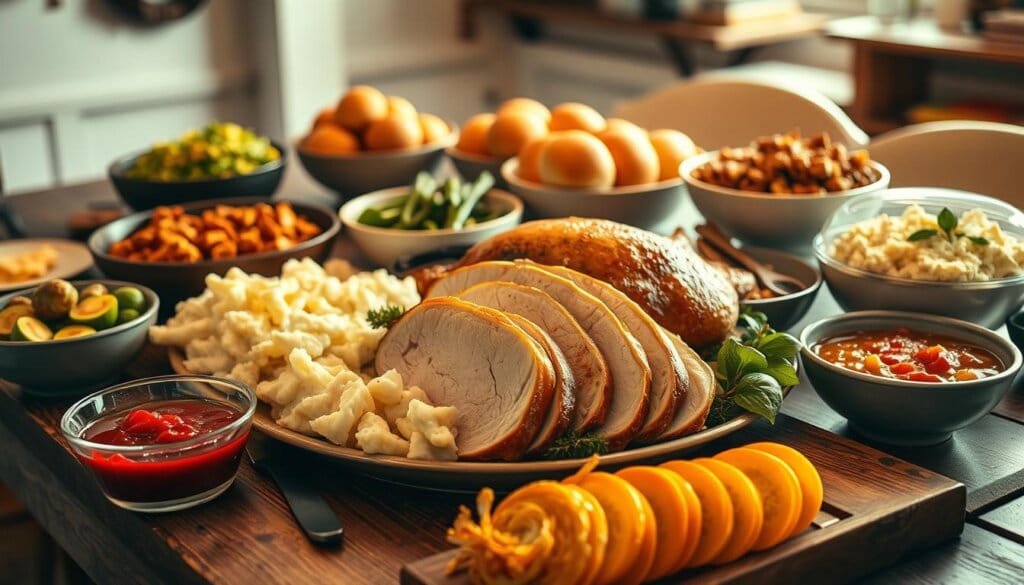Oven-Baked Turkey Legs Recipe – Juicy & Flavorful
Table of Contents
The smell of turkey legs cooking in your home is truly special. It makes everyone look forward to a delicious meal. Whether it’s a big family dinner or a cozy night in, Oven-Baked Turkey Legs Recipe is more than food. It’s a way to bring people together and make memories.
This recipe will teach you how to make turkey legs that are both tender and full of flavor. Turkey drumsticks are not only tasty but also very versatile. You can serve them as the main dish or use them in other meals later. They’re sure to become a favorite in your household.
So, let’s get started on this tasty journey. We’re going to make some amazing turkey legs in the oven. It’s time to create a meal that will warm your heart and fill your home with delicious smells!
Key Takeaways
- Oven-baked turkey legs are a flavorful and succulent alternative to traditional turkey preparations.
- This recipe serves 4 to 6 people, making it ideal for gatherings.
- Baking turkey legs at 350°F ensures juicy meat and crispy skin.
- With a prep and total time of just over an hour, it’s a quick and impressive dish.
- The internal temperature should reach 180°F for perfectly cooked turkey legs.
- Leftovers can be stored in the fridge for up to 4 days, perfect for creative meal ideas.
Introduction to Oven-Baked Turkey Legs Recipe
Oven-baked turkey legs are a delightful meal that’s easy to make. This method ensures juicy turkey legs and simplifies cooking. It’s great for small gatherings because it keeps the meat tender and flavorful.
Benefits of Baking
Baking turkey legs has many advantages over frying or grilling. The oven’s even heat prevents dryness, making the meat tender. It’s also convenient, allowing you to relax while it cooks.
Key Ingredients
To get the best flavor, you’ll need a few key ingredients. Start with 3-pound turkey legs for two generous portions. Use olive oil for moisture and softened butter for richness.
Add herbs like rosemary, thyme, and sage for extra flavor. Use about half a teaspoon of each. Turkey or chicken broth adds moisture during cooking.
Preparing Your Turkey Legs
Getting your turkey legs ready is key to a tasty meal. A step-by-step approach can make your roasted turkey taste better and feel softer. We’ll show you how to thaw frozen turkey legs and clean and dry them properly.
Thawing Frozen Turkey Legs
To thaw frozen turkey legs safely, put them in the fridge for about 24 hours. This slow thawing prevents bacteria from growing. If you’re short on time, you can thaw them in cold water.
Just make sure to change the water every 30 minutes. Always cook the turkey legs right after thawing for the best taste and safety.
Cleaning and Drying
After thawing, clean the turkey legs well. Rinse them under cold water and remove any feathers or dirt. Then, dry them with paper towels.
This step is often missed, but it’s critical for crispy skin. If the skin is wet, it will steam instead of roast. This can ruin your goal of juicy turkey legs.
| Step | Action | Time Required |
|---|---|---|
| Thawing | In refrigerator | 24 hours |
| Thawing | Submerge in cold water | 1-3 hours |
| Cleaning | Rinse and remove debris | 5 minutes |
| Drying | Pat with paper towels | 2 minutes |
Marinating for Flavor
Marinating makes turkey legs taste better and become tender. A good marinade can transform simple turkey drumsticks into a dish to remember. Choose a marinade that balances flavors well and complements your turkey leg recipe. The right mix can make your dish stand out.
Choosing the Right Marinade
There are many marinade options. Citrus-based ones tenderize, while herb-infused ones add depth. A classic mix includes olive oil, lemon zest, and fresh herbs. It balances acidity with richness.
For a spicy kick, try a Cajun rub with paprika and cayenne pepper. It adds a bold flavor.
Recommended Marinade Ingredients
Here are some key ingredients for a memorable marinade for turkey legs:
- Olive Oil: 2 tablespoons for richness.
- Garlic Powder: 1 tablespoon for aroma.
- Onion Powder: 1 tablespoon for flavor.
- Thyme: 1 teaspoon for earthiness.
- Rosemary: 1 teaspoon for fragrance.
- Balsamic Vinegar: 1/4 cup for sweetness and tang.
- Honey: 2 tablespoons to balance acidity.
- Dijon Mustard: 2 tablespoons for depth.
For the best taste, marinate turkey legs for at least 2 hours or overnight. This time lets the flavors soak in, making the turkey moist and juicy. Marinating not only enhances flavor but also keeps the meat moist through slow cooking.
Seasoning Your Turkey Legs
Seasoning is key to making baked turkey legs taste amazing. The right mix of herbs and spices can turn simple turkey legs into a delicious dish. Choose the best herbs and spices to bring out the meat’s natural flavor, making each bite full of taste.
Essential Herbs and Spices
For the perfect seasoning, use a mix of:
- Garlic powder
- Paprika
- Dried thyme
- Oregano
- Black pepper
These ingredients add depth and complement the turkey’s natural flavor. A strong rub will make your turkey legs taste incredible.
How to Properly Season
To season your turkey legs right, follow these steps:
- Start by drying the turkey legs with paper towels. This helps the seasonings stick better.
- In a bowl, mix your chosen seasonings well.
- Then, rub the mixture all over the turkey legs, covering every inch.
- For even more flavor, let the seasoned legs rest for at least 30 minutes before cooking. This lets the flavors soak into the meat.
This method makes your turkey legs not only tasty but also the star of any meal.
Prepping the Oven

Getting your oven ready is key to baking perfect turkey legs. The right oven temperature and baking method are important. Choosing between convection baking and regular bake can make a big difference in taste and texture.
Ideal Oven Temperature
The best oven temperature for turkey legs is about 400°F. This temperature cooks the meat evenly and crisps the skin. If you bake at 350°F, it might take about 30 minutes longer.
Remember, the turkey should reach an internal temperature of at least 165°F. Adjusting the temperature helps achieve the perfect doneness.
Using Convection vs. Regular Bake
Convection baking has its perks. It uses a fan to spread heat evenly. This can make turkey legs cook faster and taste better, with a crispy outside and juicy inside.
Regular bake works well too, but it doesn’t have the air circulation of convection baking. This can lead to uneven browning. For a crispy exterior, convection baking is a good choice.
The Baking Process
Creating delicious turkey legs starts with understanding the baking process. It’s important to know how to place the legs in the oven. Also, keeping an eye on cooking times and temperature is key to perfect results.
Placing Turkey Legs in the Oven
First, preheat your oven to 350°F (176°C). Place the turkey legs in a single layer on a baking sheet or roasting pan. You can use Reynolds Wrap® Heavy Duty Foil for easier cleanup.
Make sure the legs have enough space for even heat. This is vital for cooking them right.
Cooking Time and Temperature Control
Cooking time depends on the turkey leg size. Smaller legs, about 1 lb, need about 1 hour. Larger legs, 2 to 3 lbs, take about 2 hours.
To get that crispy skin, increase the oven temperature to 400°F (200°C) for the last 15 minutes. Always check the internal temperature with a digital thermometer. It should be at least 170°F (77°C) in the thickest part of the leg.
Watching both the turkey baking time and the internal temperature is important. This ensures a juicy, flavorful meal that will impress your guests.
Basting for Moisture

Basting is key to keeping your turkey legs moist. By adding flavorful liquids during cooking, you make sure each bite is juicy and tasty. This technique can make your turkey legs tender and full of flavor.
Importance of Basting
Basting does more than just add flavor. It also gives the skin a golden color. It keeps the turkey legs from drying out, making them more enjoyable to eat. This is important because turkey legs can dry out fast if not basted properly.
Basting Procedures
To baste your turkey legs well, follow these steps:
- Start by melting 2-3 tablespoons of butter or using pan drippings.
- Every 15-20 minutes, open the oven and drizzle or brush the melted butter or drippings over the turkey legs. This keeps the meat moist.
- For extra flavor, add broth or your favorite herbs to the basting liquid.
By following these basting steps, you’ll get juicy turkey legs. They’ll be full of flavor and tender for your meal.
Checking for Doneness
It’s important to make sure your turkey legs are cooked right. This is for both safety and taste. The best way to check is with a meat thermometer. It helps ensure the turkey reaches a safe internal temperature of 165°F.
Using a Meat Thermometer
Insert a meat thermometer into the thickest part of the turkey leg. Make sure it’s not touching bones. This gives you the most accurate reading. Always aim for a minimum of 165°F for safety.
Even if the meat looks a bit pink, it’s safe as long as it hits the 165°F mark. The ThermoWorks Thermapen ONE is a great choice for its quick and precise readings.
Signs of Properly Cooked Turkey Legs
Look for clear juices and no pink meat when you cut into the turkey. These signs show it’s cooked well. Checking after two-thirds of the cooking time helps avoid overcooking.
By carefully checking the turkey, you’ll get a dish that’s both juicy and flavorful. Everyone will love it.
Serving Suggestions

Serving turkey should aim to make your meal enjoyable and balanced. Pairing your baked turkey legs with the right side dishes can make the flavors pop. This creates a satisfying and impressive plate.
Pairing with Side Dishes
Choose side dishes that offer different textures and tastes. This will make your turkey shine. Here are some great options:
- Creamy mashed potatoes contrast nicely with the turkey’s tenderness.
- Cranberry sauce adds a tangy sweetness that complements the turkey’s savory taste.
- Green salads add a refreshing crunch to your meal.
- Roasted vegetables like carrots and Brussels sprouts bring a rich flavor.
Presentation Ideas
How you present your turkey is just as important as the taste. Here are some ideas to make your dish look great:
- Place the turkey legs on a large platter for a welcoming display.
- Top with fresh herbs like rosemary or thyme for a burst of color.
- Position the legs upright on the plate for a visually appealing height.
- Use decorative serving dishes to add elegance to your meal.
Leftover Turkey Leg Recipes
Thanksgiving often leaves you with a lot of turkey, like legs. You can turn these leftovers into tasty new dishes. This way, you can make your meals more interesting and reduce waste.
Creative Ways to Use Leftovers
You can make many dishes with leftover turkey that taste great and look good. Some favorites include:
- Turkey Soup: This warm dish is made by simmering turkey with veggies, loved by about 60% of families.
- Turkey Sandwiches: Put turkey, gravy, stuffing, and cranberry sauce between bread for a tasty meal.
- Turkey Tacos: Cook turkey in citrus and broth for a fresh taste.
- Leftover Turkey Casserole: Mix turkey with sides and bake for a meal everyone will enjoy.
- Turkey Grain Bowls: Mix turkey with grains for a healthy, gluten-free meal.
These recipes serve 4 to 8 people. They use different ingredients to make your leftover turkey special.
Storing Leftovers Properly
It’s important to store turkey right to keep it fresh. Cool leftover turkey in the fridge within 90 minutes. Once it’s cold, it can stay fresh for up to 48 hours. For longer storage, wrap it well and freeze in sealed containers to avoid freezer burn.
By following these tips, you can enjoy your turkey leftovers safely and deliciously. Quick and creative recipes let you enjoy Thanksgiving flavors long after the big day.
Conclusion and Final Tips
Starting to bake turkey legs? Remember the key steps to do it right. First, thaw and clean your turkey legs. Then, marinate them to add flavor. Don’t forget to season well with herbs and spices.
Keep an eye on the oven temperature, around 350°F (175°C). Baste them now and then to keep them moist. Use a meat thermometer to check the internal temperature. It should reach 165°F (74°C) for safety.
This guide will help you make juicy, tasty turkey legs. Feel free to try new marinades or cooking methods like roasting or braising. Let your creativity shine in the kitchen. Each try is a chance to get better at cooking.
Baking turkey legs is more than just a recipe. It’s about exploring new tastes and improving your cooking skills. So, get your ingredients ready, prep carefully, and enjoy making a meal to share with loved ones. Happy cooking and enjoy your creations!
FAQ
How do I ensure my baked turkey legs remain juicy?
Can I use frozen turkey legs for this recipe?
What herbs and spices work best for seasoning turkey legs?
What is the ideal oven temperature for baking turkey legs?
How often should I baste my turkey legs while baking?
What should I serve with baked turkey legs?
How can I make sure my baked turkey legs are fully cooked?
What are some creative ways to use turkey leftovers?
What is the best way to store leftover turkey legs?
Enjoyed the recipe? We’d love to hear your thoughts! Leave a review and share your feedback in the comments – your input helps us bring you even more delicious dishes!
There are no reviews yet. Be the first one to write one.







